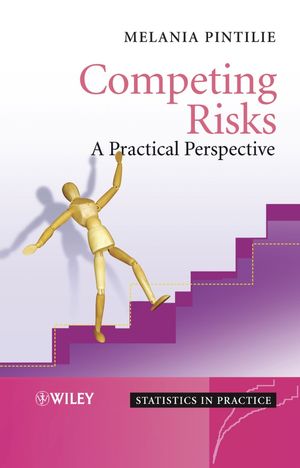Competing Risks: A Practical PerspectiveISBN: 978-0-470-87068-6
Hardcover
240 pages
October 2006
 This is a Print-on-Demand title. It will be printed specifically to fill your order. Please allow an additional 10-15 days delivery time. The book is not returnable.
|
||||||
Acknowledgements.
1. Introduction.
1.1 Historical notes.
1.2 Defining competing risks.
1.3 Use of the Kaplan–Meier method in the presence of competing risks.
1.4 Testing in the competing risk framework.
1.5 Sample size calculation.
1.6 Examples.
1.6.1 Tamoxifen trial.
1.6.2 Hypoxia study.
1.6.3 Follicular cell lymphoma study.
1.6.4 Bone marrow transplant study.
1.6.5 Hodgkin’s disease study.
2. Survival – basic concepts.
2.1 Introduction.
2.2 Definitions and background formulae.
2.2.1 Introduction.
2.2.2 Basic mathematical formulae.
2.2.3 Common parametric distributions.
2.2.4 Censoring and assumptions.
2.3 Estimation and hypothesis testing.
2.3.1 Estimating the hazard and survivor functions.
2.3.2 Nonparametric testing: log-rank and Wilcoxon tests.
2.3.3 Proportional hazards model.
2.4 Software for survival analysis.
2.5 Closing remarks.
3. Competing risks – definitions.
3.1 Recognizing competing risks.
3.1.1 Practical approaches.
3.1.2 Common endpoints in medical research.
3.2 Two mathematical definitions.
3.2.1 Competing risks as bivariate random variable.
3.2.2 Competing risks as latent failure times.
3.3 Fundamental concepts.
3.3.1 Competing risks as bivariate random variable.
3.3.2 Competing risks as latent failure times.
3.3.3 Discussion of the two approaches.
3.4 Closing remarks.
4. Descriptive methods for competing risks data.
4.1 Product-limit estimator and competing risks.
4.2 Cumulative incidence function.
4.2.1 Heuristic estimation of the CIF.
4.2.2 Nonparametric maximum likelihood estimation of the CIF.
4.2.3 Calculating the CIF estimator.
4.2.4 Variance and confidence interval for the CIF estimator.
4.3 Software and examples.
4.3.1 Using R.
4.3.2 Using SAS.
4.4 Closing remarks.
5. Testing a covariate.
5.1 Introduction.
5.2 Testing a covariate.
5.2.1 Gray’s method.
5.2.2 Pepe and Mori’s method.
5.3 Software and examples.
5.3.1 Using R.
5.3.2 Using SAS.
5.4 Closing remarks.
6. Modelling in the presence of competing risks.
6.1 Introduction.
6.2 Modelling the hazard of the cumulative incidence function.
6.2.1 Theoretical details.
6.2.2 Model-based estimation of the CIF.
6.2.3 Using R.
6.3 Cox model and competing risks.
6.4 Checking the model assumptions.
6.4.1 Proportionality of the cause-specific hazards.
6.4.2 Proportionality of the hazards of the CIF.
6.4.3 Linearity assumption.
6.5 Closing remarks.
7. Calculating the power in the presence of competing risks.
7.1 Introduction.
7.2 Sample size calculation when competing risks are not present.
7.3 Calculating power in the presence of competing risks.
7.3.1 General formulae.
7.3.2 Comparing cause-specific hazards.
7.3.3 Comparing hazards of the subdistributions.
7.3.4 Probability of event when the exponential distribution is not a valid assumption.
7.4 Examples.
7.4.1 Introduction.
7.4.2 Comparing the cause-specific hazard.
7.4.3 Comparing the hazard of the subdistribution.
7.5 Closing remarks.
8. Other issues in competing risks.
8.1 Conditional probability function.
8.1.1 Introduction.
8.1.2 Nonparametric estimation of the CP function.
8.1.3 Variance of the CP function estimator.
8.1.4 Testing a covariate.
8.1.5 Using R.
8.1.6 Using SAS.
8.2 Comparing two types of risk in the same population.
8.2.1 Theoretical background.
8.2.2 Using R.
8.2.3 Discussion.
8.3 Identifiability and testing independence.
8.4 Parametric modelling.
8.4.1 Introduction.
8.4.2 Modelling the marginal distribution.
8.4.3 Modelling the Weibull distribution.
9. Food for thought.
Problem 1: Estimation of the probability of the event of interest.
Problem 2: Testing a covariate.
Problem 3: Comparing the event of interest between two groups when the competing risks are different for each group.
Problem 4: Information needed for sample size calculations.
Problem 5: The effect of the size of the incidence of competing risks on the coefficient obtained in the model.
Problem 6: The KLY test and the non-proportionality of hazards.
Problem 7: The KLY and Wilcoxon tests.
A: Theoretical background.
B: Analysing competing risks data using R and SAS.
References.
Index.



